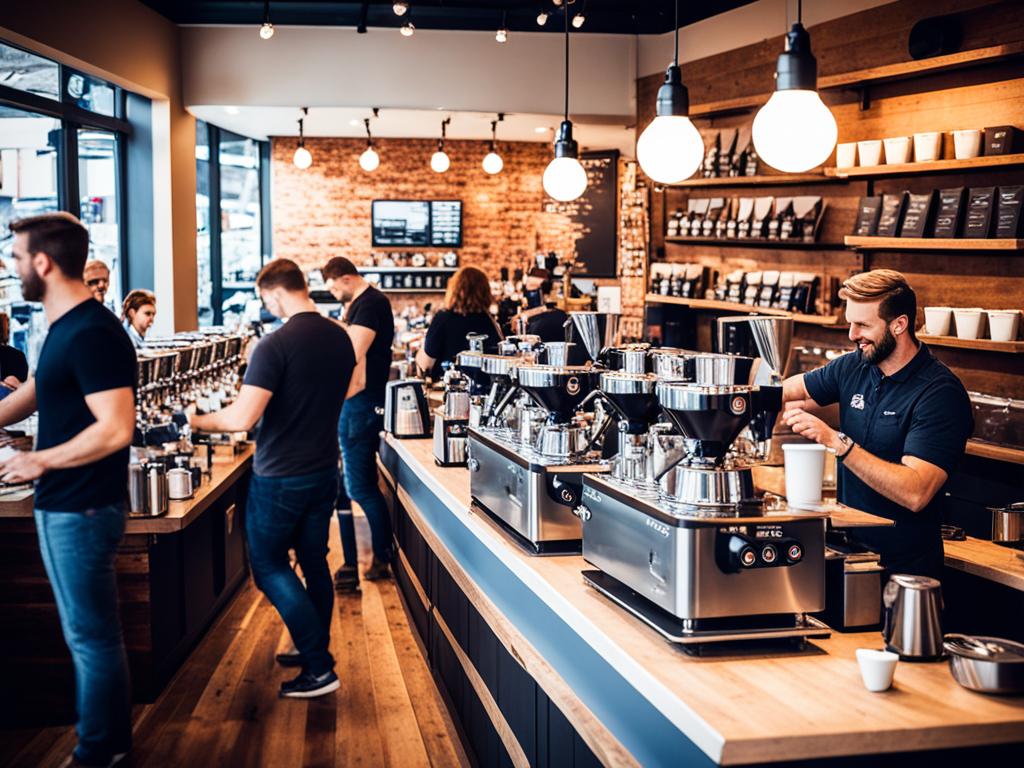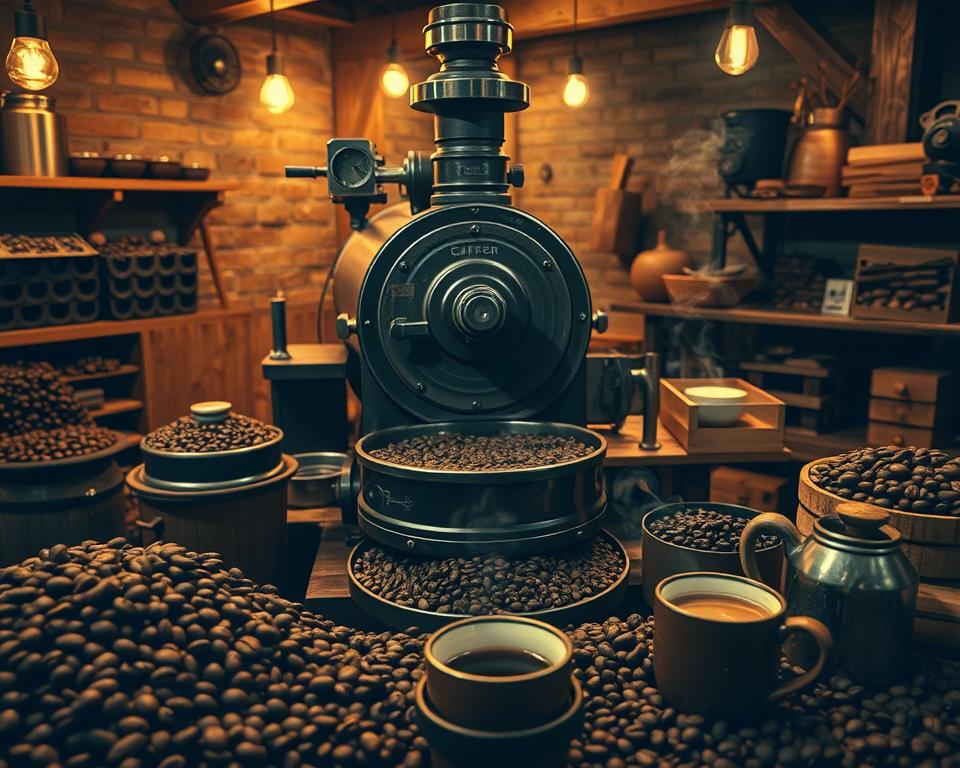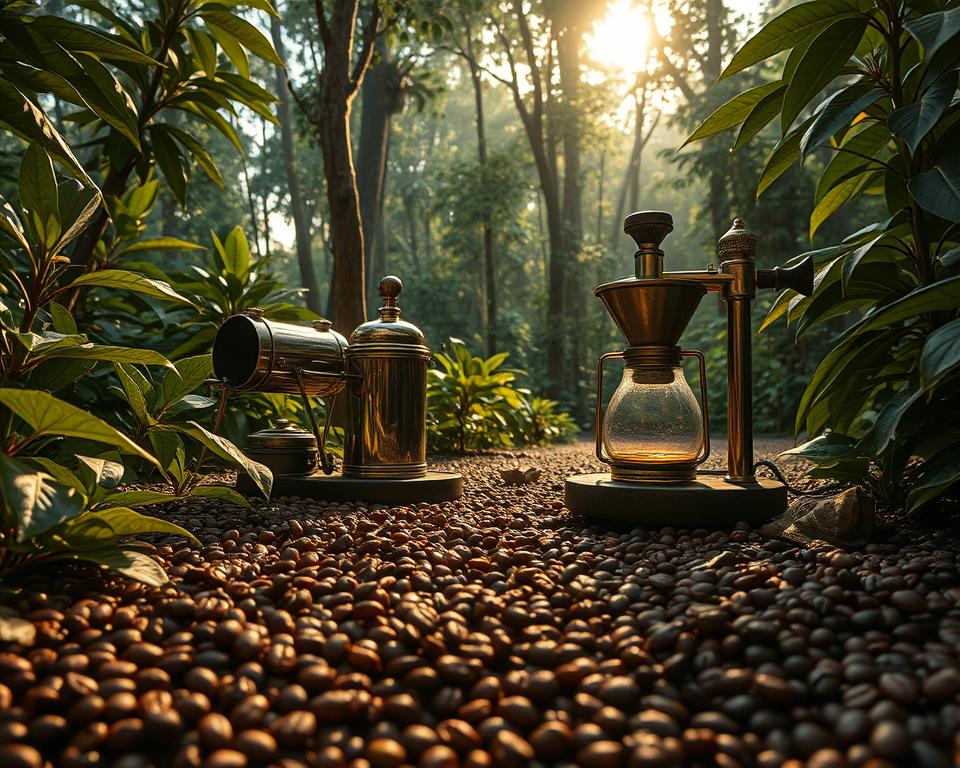Exploring the world of coffee reveals a strong trend. America loves specialty coffee. It’s tempting to think about how to start a coffee roasting business in this growing field. 60% of the coffee consumed in the U.S. comes from the specialty coffee market. This shows a huge demand for premium brews. But starting this type of business is not simple.
Starting a roasting business requires a hefty investment, around $120,000 on average. Despite the cost, the potential for success is enticing. The costs include buying commercial coffee roasters and following EPA regulations for large roasting operations.
Yet, I find myself curious about making money in this field. Selling a 12-ounce bag of roasted coffee ranges from $12 to $20.
I want to show you how to thrive in the coffee business. We’ll look at marketing and the skill of roasting coffee. Let’s explore how to start a coffee-roasting business.
Key Takeaways
- Recognize the influence of the specialty coffee market in the current U.S. coffee industry.
- Understand the financial requirements to cover startup costs for a coffee roasting business.
- Learn about the pricing and expenses for equipment and tools essential for roasting coffee.
- Identify potential revenue streams and strategies for a profitable coffee roasting operation.
- Gain insights into the retail vs. wholesale pricing structure and the importance of marketing your coffee brand.
Gauging the Profitability of Coffee Roasting
Exploring the specialty coffee world means I must grasp coffee roasting profit margins. This knowledge is essential for my business’s triumph. It guides me towards making profits in this competitive market.
Understanding Coffee Roasting Profit Margins Compared to Coffee Shops
My studies reveal a striking profit difference between roasting and running coffee shops. Roasters enjoy bigger financial benefits. Their margins often outshine those of retail coffee shops, thanks to less overhead and bulk sales.
Customer loyalty programmes also play a significant role in financial health. Even though many don’t use their rewards, loyal customers help stabilise the base. This can mean lower costs. Digital menu boards, too, cut down on expenses and are eco-friendlier than print.
Expectations for Return on Investment in Coffee Roasting
Starting a coffee roastery comes with its own set of costs. The expected coffee roasting ROI greatly influences beginning choices. A quality roaster’s price range is wide, but the potential returns make it worthwhile.
Digital improvements and holding events like cuppings boost the roastery’s appeal. They not only diversify income but also build the brand. This can lead to more sales and a stronger presence in the market.
Case Study: Roasters Succeeding in a Retail Environment
Retro Coffee exemplifies adaptation and success. They’ve capitalised on trends, such as selling retail bags during moments when home coffee was in demand. A smart roaster observes both numbers and consumer behaviours for success clues.
As I launch a coffee roasting startup, I pay close attention to green coffee costs and how much coffee people drink worldwide. Entering this vast market demands careful cost management and recognising coffee’s global significance.
Realizing the global reliance on coffee, I see the impact of my venture. It emphasises my duty to promote ethical and sustainable methods.
Diving into specific expenses, like fluctuating green coffee prices, prepares me for market changes. Coffee’s price volatility is just part of a larger strategy. I must also consider employment, operations, and marketing to sketch out probable profits.
The smell of fresh coffee beans signifies more than pleasure. It symbolises engagement in a profitable industry. My goal to craft the perfect roast is not just about flavor. It’s a financial journey that covers all aspects, from bean cost to final cup price.
Devising Your Coffee Roasting Business Model
Starting a coffee roasting business might seem tough, but it’s really about the basics. Let’s dive into the steps to start coffee roasting without getting overwhelmed.
First, get to know the market. In 2018, coffee shops in the US made $45.4 billion. To fit in, you need a smart plan. Maybe find a special spot for affordable, high-quality roasts. Knowing these points is vital to the coffee roasting business.
Now, let’s talk about the beans and equipment. Setting a budget for gear is crucial. Roasters can be pricey, ranging from $3,000 to $58,000. You want a machine that tracks temperature and roast colour for top results.
Good equipment means a strong business foundation! Here’s an expert tip that matters: “Invest in the right equipment to ensure consistency.”. It’s critical for your success.
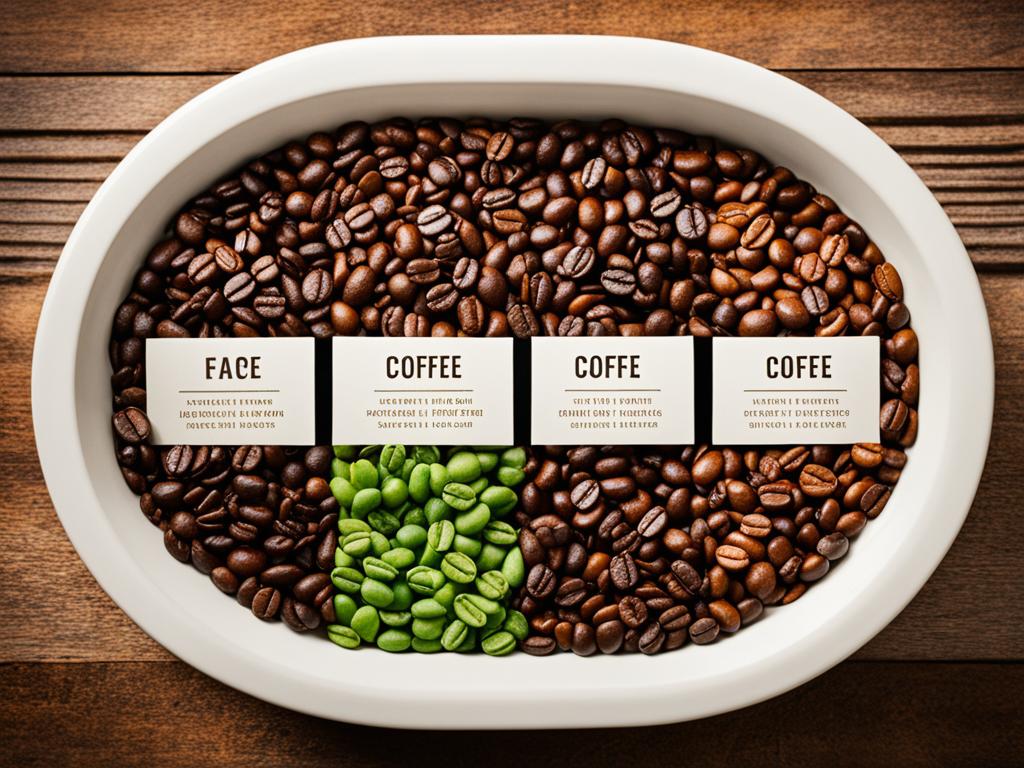
Financing boosts your business. Think about getting help from friends and family. This can keep you away from heavy debt. Also, offering free cupping sessions at local coffee shops is smart. It builds relationships and teaches people about your product.
Here’s an overview of some important costs:
- Commercial coffee roasters are priced from $3,000 to $58,000.
- Choosing smart equipment is key—it should help keep your coffee consistent.
- Getting funds from people you know could lower risks and costs.
- Hosting free classes helps build a loyal community and client base.
Lastly, here are some key figures to consider:
| Starting Asset | Cost | Impact |
|---|---|---|
| Commercial Coffee Roaster | $3,000 – $58,000 | Consistency & Quality of Roast |
| Market Research | Variable | Understanding What Customers Want |
| Finance | Personal | Avoids Initial Debt |
| Educational Events | Helping the Community | Increases Brand Loyalty |
Creating a business from scratch is more than a recipe. You need to add your own unique flavor. For extra tips, dive into these coffee-roasting business essentials that I find very insightful. Keep your energy high!
How to Start a Coffee-Roasting Business
Starting a coffee roasting business comes with challenges. But with the right know-how, tapping into the specialty coffee market is doable. 60% of U.S. coffee drinkers prefer specialty coffee.
This shows there’s a big chance for success if you plan well and understand the market.
Choosing the Right Coffee Roaster
Selecting the right coffee roaster is crucial. Think about size, cost, and how it works with your tech. Commercial roasters can cost between $20,000 and $150,000.
Find one that matches your starting size but can grow with you. A smaller roaster to begin with means you can adjust easily with fewer losses, then grow as needed.
Calculating Upfront and Hidden Costs
Start-up costs range from $30,000 to $128,000. You must also think about your location’s down payment and trial runs. Don’t forget about registering with the FDA and possibly needing EPA permits for large roasters. A detailed plan helps avoid unexpected costs, making a coffee roasting business guide crucial for budgeting.
Green Coffee Beans: Selection and Cost
The price of green coffee beans varies a lot. You might pay less than $2/lb or more than $6/lb. A good estimate is about $4/lb. To make a profit, sell roasted coffee at $16/lb. You need to sell around 300 pounds monthly to hit your profit goals. Success combines business smarts with a love for coffee.
Getting a coffee roasting business guide is essential. It offers valuable tips and an understanding of both the coffee and business sides. Here is a quick look at the initial costs:
| Expense Category | Cost Range |
|---|---|
| Commercial Coffee Roaster | $20,000 – $150,000 |
| Start-Up Costs | $30,000 to $128,000 |
| Quality Green Beans (per lb) | $2 – $6 |
| Advertising & Marketing | Varies (necessary budget) |
| Permits and Registrations | Varieties per state and volume |
By planning for these costs and using the best tips and tools, you can turn your coffee passion into a successful business. Every choice, from the roaster to the beans, shapes your company’s story. It ensures that your unique touch and customer happiness are key.
Mastering Coffee Roasting Techniques and Education
Starting a coffee roasting business taught me the importance of learning the craft deeply. Education goes beyond just books; it’s about hands-on learning and ongoing improvement.
Through “The Coffee Roaster’s Companion” by Scott Rao and “The World Atlas of Coffee” by James Hoffman, I’ve built a solid roasting foundation.
Professional Roasting Courses and Certifications
The Specialty Coffee Association’s certifications have greatly boosted my credibility and skills. Their professional cupping and roasting courses mix global standards with practical experience. This keeps me updated with the latest in coffee roasting.
Experimenting with Coffee Flavors and Blends
Exploration is key for roasters looking to go beyond what they’ve read. I find it exciting to apply tips from YouTube coffee experts directly to my roasting process.
Whether using a cast-iron skillet for a unique touch or a high-tech drum roaster, every batch is a new lesson in flavour.
The importance of continuous learning
The coffee industry is always changing, and we have to keep up. I rely heavily on the online coffee roasting community through forums, social media, and blogs. Staying current with tech like data-logging software improves my roasting precision.
Sustainable methods and focusing on single-origin beans define our brand’s narrative of quality and care. It’s a story told through each cup of coffee we produce. In the end, continuous learning is what drives my business and its high-quality coffee forward.
Creating a Market-Focused Branding Strategy
In the bustling marketplace of coffee roasting, having a strong coffee roasting branding strategy is key. It guides entrepreneurs to success. I see that a unique coffee roasting brand identity is more than a logo or slogan.
It’s the business’s soul, in every bean roasted and every cup brewed.
Defining Your Coffee Roasting Business Identity
Developing a brand’s identity means exploring its core values and unique features. This might include focusing on sustainably sourced beans or the art of home roasting.
With 75% of Americans drinking coffee daily, small brands can win hearts with a personal touch.
Positioning your brand in the coffee roastery market
Understanding market dynamics is essential. Online coffee sales are growing by 12% each year. The industry is not just alive; it’s booming. This growth offers chances for niche targeting and creative engagement strategies. It’s crucial to find where your brand belongs in this vast market, maybe with dropshipping coffee beans or a range of branded products.
Building a Connection with Your Target Audience
In today’s digital world, having an audience means building a community. Analyzing demographics and psychographics to understand what drives potential customers is vital.
Through social media and promotions, I’m not just selling coffee. I’m sharing a story that emphasises quality and niche markets. It’s about creating a bond.
| Market Segment | Projected Revenue Increase |
|---|---|
| Coffee Houses | $13,009 over 12 months |
| Restaurants | $13,009 over 12 months |
| Grocery Stores | $13,009 over 12 months |
Selecting the right beans, perfecting the roast, or inventing a new flavor profile reflects our brand identity. By putting passion and authenticity into each step, our branding strategy does more than just business. It makes us stand out and grow in a world that depends on our coffee every day.
Sourcing and Equipment: The Foundation of Your Roastery
Starting my coffee roasting journey showed me how crucial green coffee bean sourcing is. I also learned the importance of the right coffee roasting equipment. It was clear I needed beans that were top-notch, sustainable, and ethically sourced. The success of my roasts, and thus my brand, depended on it.
Choosing the right equipment was key to my operation’s success. The coffee roaster capacity was particularly important. It impacted the quality and quantity of what I could produce.
I chose a commercial-grade roaster that aligned with my business needs. This decision was critical for my roastery’s future success.
Below is a table that shows why researching and investing in the right gear is essential:
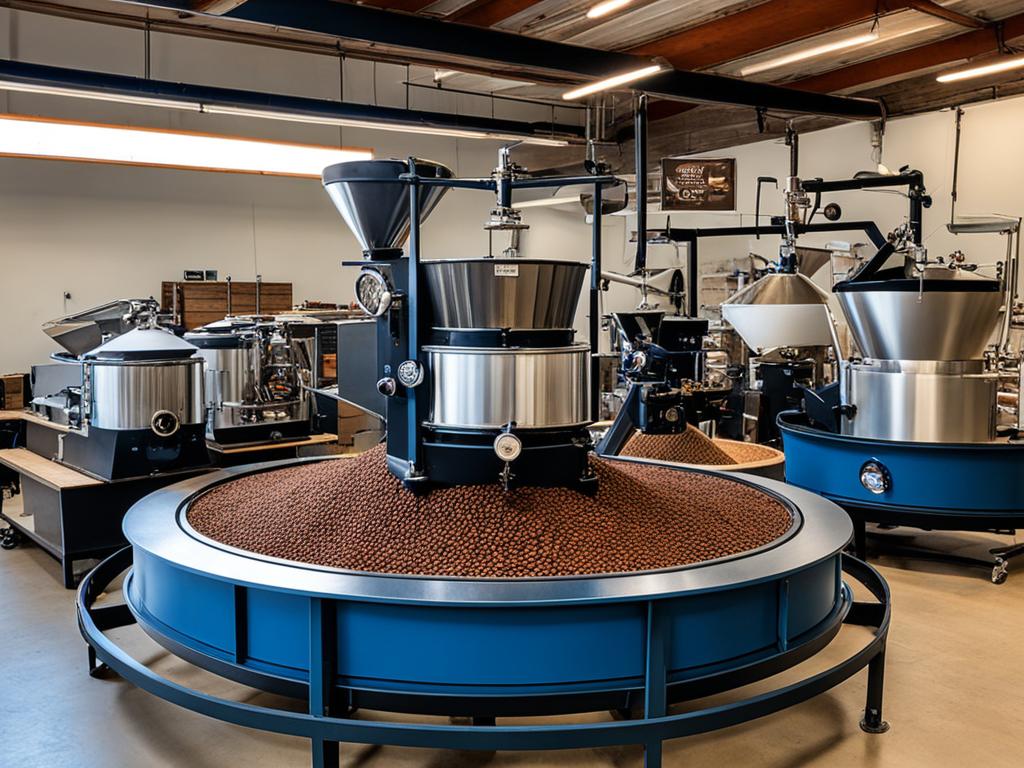
| Equipment Type | Capacity | Importance |
|---|---|---|
| Commercial Roaster | 10-60 kg/batch | Central to achieving the desired roast profile and volume |
| Sample Roaster | 100-500 g/batch | Essential for testing and developing new roasts |
| Grinders | Varies | Crucial for consistent grinding and flavor extraction |
| Roasting Software | N/A | Improves consistency and tracking of roast profiles |
As I looked at the numbers and planned, I focused on two important things. The freshness of the beans and precise roasting conditions are key. I knew I couldn’t cut corners here. After all, they are the foundation of a perfect cup of coffee.
What Steps Do I Need to Take to Start a Coffee Roasting Business Before Opening a Coffee Shop?
Before launching a coffee roasting business, it’s crucial to research coffee shop licensing requirements. This involves understanding local regulations, health permits, and zoning laws. Additionally, developing a business plan, sourcing quality beans, and establishing a roasting process will position you for success when opening your coffee shop.
Conclusion
I’ve talked about starting a coffee roasting business. It’s more than a trend; it could be a big success in the $11 billion US coffee market. Starting involves key steps, like building relationships with suppliers for the best beans. Also, spending wisely on equipment is key for unique coffee flavors. Coffee roasting machines are crucial for creating these flavours and making your brand stand out.
Starting a coffee roasting company also means going digital. The data shows how important online presence and social media are today. With a great logo and eco-friendly packaging, you can build a strong brand. Customer-loyalty programmes are also vital. They help keep customers coming back and create a loyal community around your brand.
The journey continues even after starting. You need to keep learning, follow trends, and listen to feedback. It’s important for your business to grow and be profitable. Paying attention to every detail, from picking the best coffee beans to meeting environmental regulations, is crucial. I aim to make my brand known for its quality and taste—a leader in the coffee world.
FAQ
To start a coffee roasting business, do your homework and make a plan. Pick the right gear and find the best green beans. You’ll need permits, a solid business plan, and a unique brand. Understanding coffee roasting is key. Consider taking professional courses to improve.
What are the expected profit margins for a coffee roasting business?
Coffee roasting businesses can see profit margins of about 11.92%. This is when they sell products wholesale and retail. These margins are higher than those of many coffee shops.
How do I gauge the profitability of my coffee roasting business?
Profitability comes from the cost of beans, efficient roasting, and your customer reach. Keep your costs low and focus on making great coffee. This will help increase your profits.
Can you provide a successful case study of a coffee-roasting business?
Retrograde Coffee succeeded by selling retail bags during the pandemic. A full case study would explore their strategy, marketing, and adjustments to stay profitable.
What should my coffee roasting business model include?
Your business model needs a target market and a sourcing plan. It should detail your equipment, prices, and how you’ll sell it. Choose between wholesale, direct sales, or both.
How do I select the right coffee roaster for my business?
Choosing the right roaster depends on your needs and budget. Look at its capacity and if it meets environmental rules. It should fit the coffee styles you want to make.
Are there any hidden costs to starting a coffee roasting business?
Yes, starting up includes costs for setup, compliance, and training. Expect to spend money to find your perfect roast. Plan for maintenance and repairs too.
Where should I source green coffee beans, and what costs are involved?
It’s vital to get quality green beans. They come from importers or directly from farmers. Prices for specialty beans range from.75 to.00 per pound. Choose beans that fit your taste and are sourced responsibly.
Why is continuous learning important in the coffee roasting industry?
The coffee world always changes, from new techniques to what customers like. Keep learning through courses and keeping up with trends. This keeps your skills sharp and your business ahead.
How can I create a strong brand identity for my coffee roasting business?
To build a strong brand, show what you stand for. Your name, logo, and packaging should all tell your story. Connect your products with values like sustainability or luxury.
How do I position my brand effectively in the competitive coffee roastery market?
Spotlight what makes you different, like unique roast profiles or ethical beans. Tell your story well in your marketing. This helps you stand out and draws customers in.
What equipment do I need to start my coffee roasting business?
Starting means getting the right tools, including a commercial roaster, sample roaster, grinder, and packaging machine. Match your equipment to your goals and how much you can spend.

